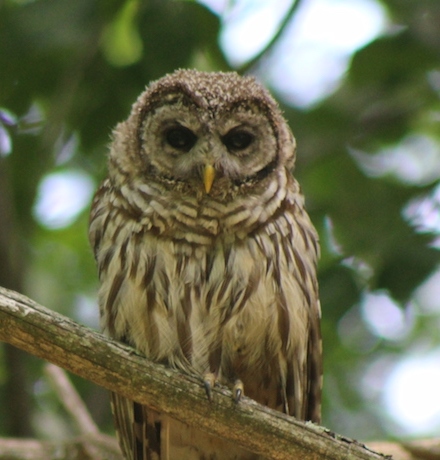Or, how I became caught up with the Wharton-Broughton duo.
It’s fair to say that this trip cemented some friendships that have stayed with me ever since. It also caused me to be willing to push myself beyond my normal limits and raised my expectations for outdoor activities for ever.
In 1982 I started work at a small company called Cirrus Computers Ltd. Many of the employees and several of the founders had been recruited from a company called ICL in Manchester, England. I was no exception. My new boss was somebody called Dave Wharton. Dave had been an engineer at ICL where his colleague and closest friend was called Phil Broughton. Dave and Phil were acquaintances of mine, but not close associates. However, one thing that I knew about them was that they were enthusiastic walkers and climbers. Dave had probably heard the same about me because I had organised several hiking trips for my colleagues at work. They may, or may not, have known that I was inexperienced in the skills of serious mountaineering, but I did have a yearning to try more adventurous activities to U.K. fell walking and long distanced path trips.
So in my first year of working for Dave, he suggested that I join him and Phil on a trip to the Alps. Specifically in Austria. I have since learned that I was second choice; a person called Gordon Cooper had been joining originally, but he dropped out because of his marriage (or something like that). Dave was not very detailed in what was going to happen other than that we would be staying in huts, that they closed in mid-September and that I should get mountaineering insurance from the British Mountaineering Council. How we would get there was TBD. I was also told that I would need to obtain basic winter mountaineering gear, specifically crampons and an ice axe. Dave told me that because ice axes are mostly just carried around then I should be concerned about weight. For these latter items, I went to an outdoor shop in Gosport, a nearby town, and rented what seemed to be a nice a pair of 10-point crampons. I also purchased a used (ex-rental) ice axe. We did not plan any ice climbing so 12-point crampons were not necessary. I don’t know if Dave will hold this against me, but I must say that his instructions what what to bring were rather scant and whenever I asked whether something was needed the response gave me that impression that it would be required. In retrospect, I have feeling that Dave knew hardly any more than I did I this regard.
The insurance always amused me because it was £25 for a full year which included helicopter rescue, but ski insurance was execatly the same price. To me this said nothing about mountaineering, but an awful lot about skiing and the risk of a broken leg, etc.
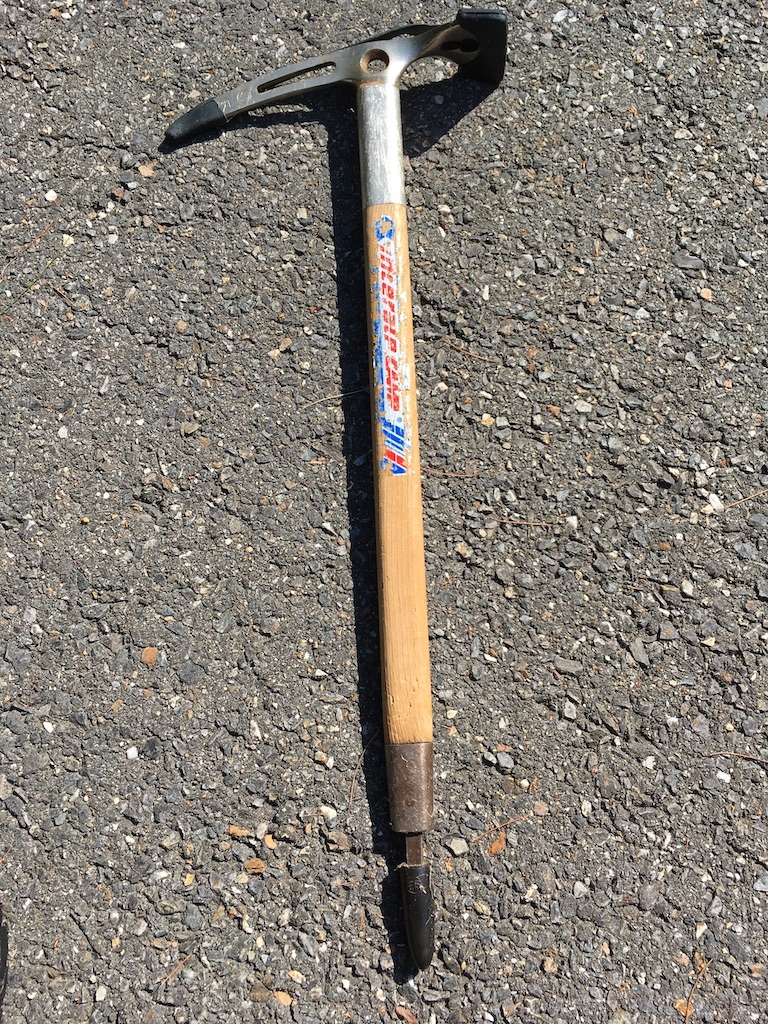
Many of the the alpine huts were built in the 1920s and 1930s during the Germanic craze for healthy outdoor activities. The two we planned to use were far from public roads. The Appalachian Mountain Club hut system is styled on these establishments and, as with the AMC huts, the remote locations are supplied by a combination of backpacking by the staff (“croo” in AMC parlance) and helicopters. In some cases cable transport systems are available, but more about that later. Since the huts were operated by the various Alpine clubs and booking accommodation with them was cheaper and easier for members, Phil joined the Österreichischer Alpenverein (Austrian Alpine Club; aka OAV). It has a close sister club in Germany called the Deutscher Alpenverein (DAV). The huts were the responsibility of individual local branches of these clubs which could be German or Austrian. There was a rule that nobody was supposed to spend more than about 3 nights in a single hut; they were (still are) used for hut-to-hut walking adventures, often run by third party commercial operations or foreign clubs like the AMC and Sierra Club.
As for our travel, we were going to the Öetztal Alps in the Central Tyrol area of Austria. I had been to Innsbruck, the largest city in the region, before in 1965 when I was 16 years old on a school trip. That trip involved a bus ride to the English Channel, the night ferry to France, an overnight train to Basel in Switzerland, and finally, a long uncomfortable train ride to Innsbruck. There was no way that I would do this again. So I took it on myself to do some research.
Innsbruck is located in a narrow valley, which limits air travel even though it has a decent airport. So a direct flight was not going to feasible. It’s possible that we could have flown to Vienna or some other city and taken a connection, but I noticed that Innsbruck is not far from the German border and only about 200 Km from Munich. So It seemed that a good idea would be to get a cheap flight from Gatwick to Munich, then use surface transport to get to Innsbruck. In those days, Dan Air was operating cheap flights and so we booked return tickets for the three of us. Phil would meet us at the airport as he was travelling from Manchester because he had chosen to remain at ICL when the exodus to Cirrus had occurred. We had been given some discount cards for Hertz by Cirrus and it did cross my mind that a car rental might help in the journey from Munich to Austria, but Phil was a devotee of “Thomas Cook’s European Timetable” which had timetables for all railways in Europe. There were good trains from Munich to Innsbruck.
So our plan was: Meet Phil at Gatwick, fly to Munich, take the train from Munch to Innsbruck, spend a night in Innsbruck at a B&B, take the post bus to Obergurgl (a small village in the Öetztal area) then we would hike the 6-8 miles to our first hut.
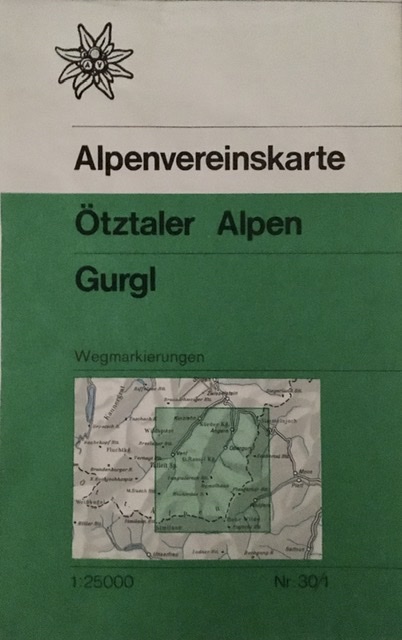
The journey from England started well. We met Phil at Gatwick. Dave had warned me that he would be carrying a “huge rucksack”. In this case it was large enough for Phil’s ice axe to be carried on the inside. I had already added extra bags to the sides of my sack, which was a nice size for weekend trips, but not large enough for a 1-week trip. These bicycle panniers were a perpetual source of jokes by Dave who had an amazingly small sack with nothing on the outside. Our axes were carried in our hands. When we checked in, the agent refused to allow us to take the axes into the cabin and insisted that they be checked in separately – all OK on the face of it.
The flight was uneventful. As was the normal expectation with Dan Air it was in an old aircraft; in our case a BAC One-Eleven, probably previously owned by British Airways. On arrival at Munich, our bags appeared at the baggage claim, but no axes. We met the airline representatives, showed our receipts and they told us to buy replacements and they would reimburse us. After our journey to Innsbruck we found an outdoor shop and purchased two axes. Mine was “Stubai” brand I seem to remember.
I can remember little about the bus ride from the airport or the train journey from Munich, but the B&B was very acceptable with a small en suite bathroom and a decent breakfast; the shower was the last we would have for many days.
The next stage was the Postbus to Obergurgl. The Alpine Postbusses were yellow and, unlike those in the UK, which were post vans with extra seats, these vehicles were busses with space for carrying the mail and also were equipped for carrying skis in season. At Obergurgl we commenced the walk with our heavy packs. At some point we had weighed our baggage. Dave’s pack was ~30 lb, mine was 40-50 lb and Phil’s was ~ 70 lb. This disparity was to turn Dave into an object of many disparaging remarks for many years to come.
The uphill walk from Obergurgl was hard to say the least. At some point we walked past the river that emerged from the end of the Langtaler Fermer (Glacier) and I was very thirsty. I ignored advice and drank from it. Glacier water can be very clear, or as in this case, can include a lot of grit which has laxative properties. They had the expected effect on me.
The Langtaler Glacier was the water supply for the Langtalereck Hutt which is at the end of a dirt road, suitable of off-road vehicles. Just before we arrived there, Dave whispered to me that he was exhausted with carrying his sack. As we passed the Hutt, operated by the Karlsruhe branch of the DAV, we noticed a small lift obviously for carrying supplies to buildings higher up the mountains. This was a saviour! Phil (or was it Dave?) went into the building and arranged for our bags to be carried the remainder of the way to our first night’s destination – the Hochwilde Haus, also operated by the Karlsruhe DAV. When we reached the hut, Dave quietly said that he could not have carried his rucksack all the way and was grateful for the lift.
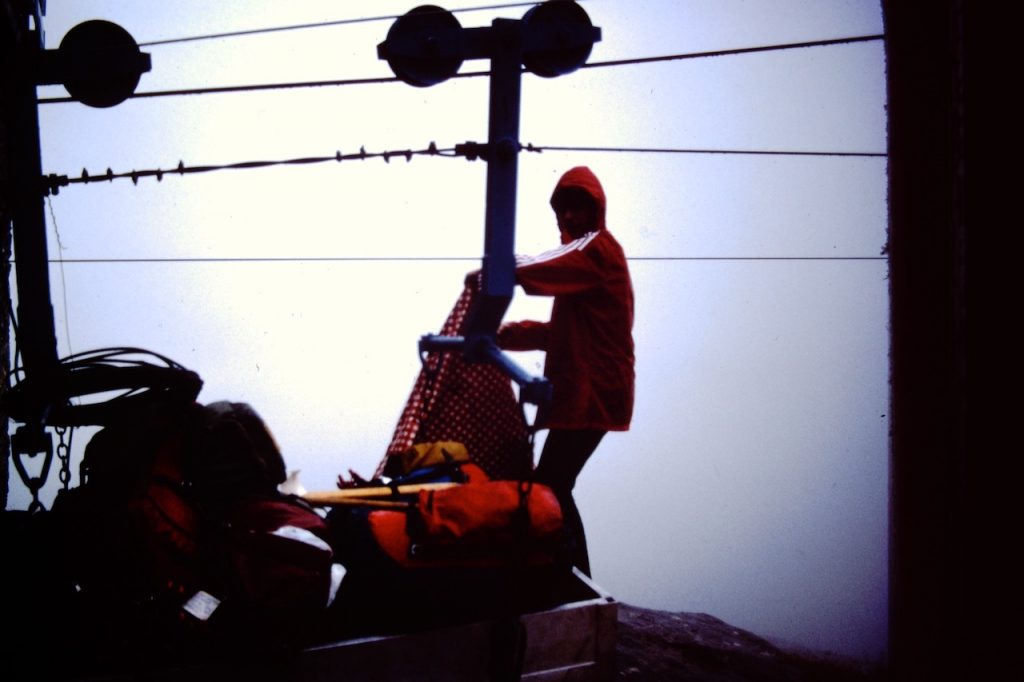
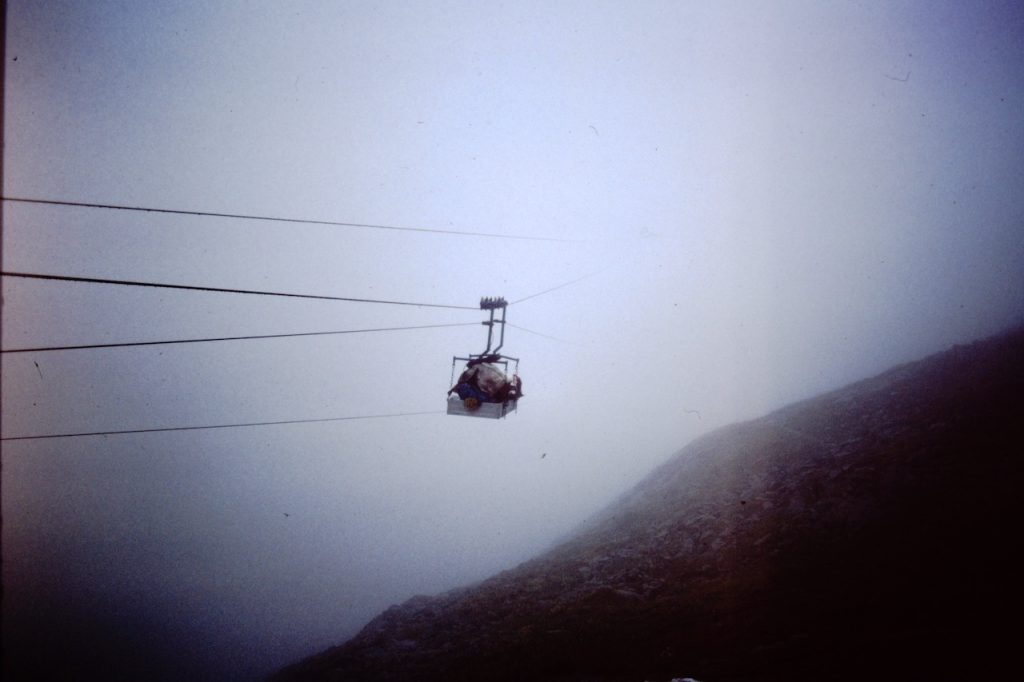
As I recall, we had two nights at the Hochwilde Haus (2866 metres) I think we had brought our own food. Two events about staying there stick on my mind. The first was snoring. At the time, I was a notorious snorer, but the racket from the multinational group of hikers and mountaineers in the bunkhouse was tremendous. The second was the cold; not too much of a comfort issue, but the pipes (or was it the brook feeding the water supply) froze and there was no water on that first morning. Unlike the AMC huts, these Alpine versions served alcohol (mainly beer). They also served meals to passing walkers, but for the first few days we had brought food along with us and were able to make use of the cooking arrangements at the hut.
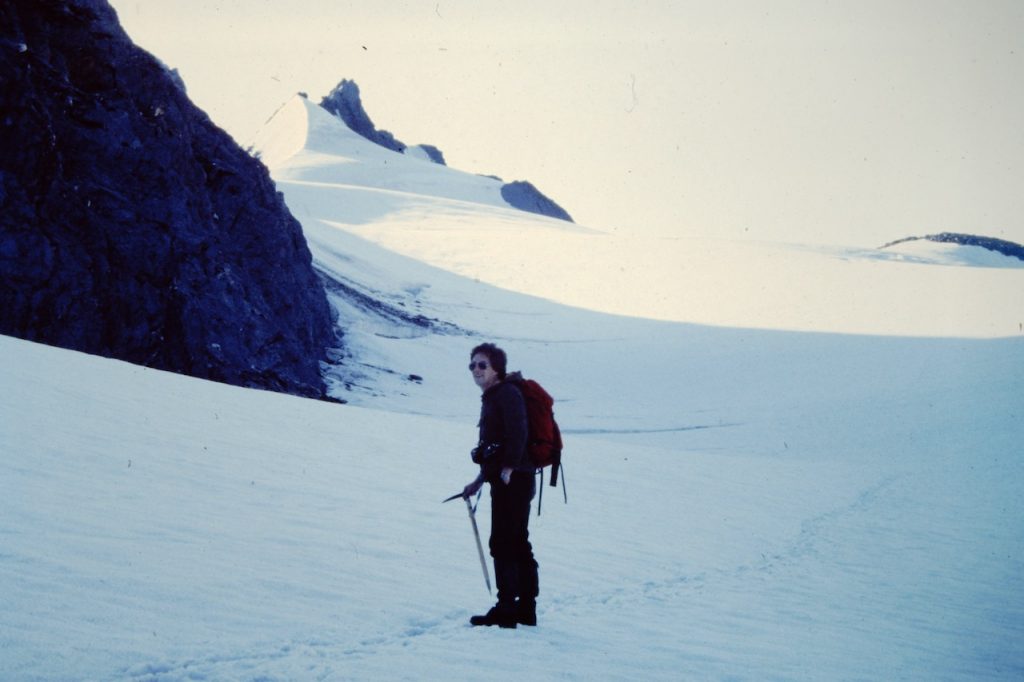
On that first (could have been Monday) day we chose to head for the Hochwilde, a peak of 3482 metres on the Italian border. The walk would take us along the Gurgle Fermer, then on to a ridge and eventually to the summit. This was my first experience of walking on a snow-covered glacier and I was given rudimentary instruction on how to walk in an area where crevasses could easily be hidden by thin snow bridges and what to do if one of us falls through. We were to be roped up and as I was the novice, I would be in the middle.
There were no mishaps as we gingerly walked though the snow. Phil or Dave was in the lead and at pretty much all steps they tested suspicious looking snow with an axe to see if there was a crevasse underneath. At some point we reached a sharp drop, probably between one of the subsidiary tops (there are two of them at 3462 and 3419 metres) and the final summit. We had climbing gear and so Phil was belayed down to find a route. Dave and I followed. As far as a remember, we left the rope in place for use on our return trip. I certainly recall us taking a decent break at this point. The view at the summit was tremendous, but even in 1982 I was reminded of climate change as we heard rocks falling on to the glacier due to the melting ice that was holding them in place.
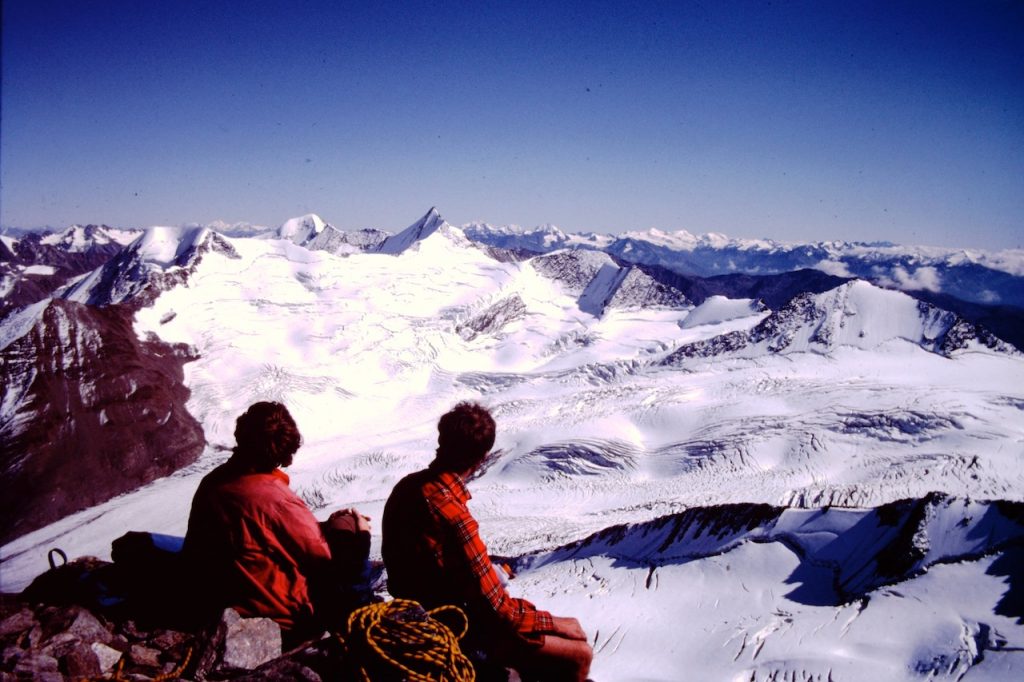
The next day we crossed the Gurgl Fermer to the Ramolhaus, operated by the Hamburg section of the DAV. This hut was some what higher, but to get there we had to descend to the glacier and then ascend about 500 metres along a well used path. The glacier was clear of snow at this point and so the crevasses were clearly visible. The “mushrooms” were also clearly visible. These are rocks perched on top of pinnacles of ice. The rocks shield the ice from the sun and so it melts slower at that point leaving the rock proud of the surroundings.
There were very few other people at the hut during this stay, probably because it was almost the end of the season, but I remember a family with a doctor with his wife and teenage children. They were doing a hut-to-hut tour and their next objective was the nearby Stubai Alps. Another party stopped in for refreshment at one point; they were probably coming from the Vent area and then would descend to Obergurgl.
We overstayed the 3-day limit by one night and apart from the occasional dirty look nobody seemed to mind, probably because of the lack of visitors. A few things I remember about this hut were that we had beer, we ate there a few times and were happy with their sausage and soup bergsteigeressen (mountaineer’s dinner). Another memory was the stink of urine; it was obvious why whenever the toilets were used, because they were more or less a seat over a hole to the glacier.
On the Wednesday, we took a walk down to Obergurgl where we bought supplies and I purchased some batteries for my camera – Phil and Dave ridiculed me for this. We also noticed a disused supply lift next to the path. Helicopters must have made it useless. We had lunch at a hotel where they sold “Germknödel”. I had seen adverts for this in many places on the way and wanted to try it. This is, or was, a very sweet lump of dumpling, very unhealthy I’m sure. Another memory of this day was seeing a coachload of elderly British tourists. I also heard the local guides laughing at them behind their backs; this added to my distrust of tour guides and a feeling that they rarely respect their clients.
I recall two hikes during our stay at the Ramolhaus. The first was to the Schalfkogel and on this day I lost my confidence in the crampons on the icy summit ridge. Dave and Phil however completed the ascent. I seem to remember an overcast day.
The second hike was to the Ramolkogel when I was far more confident and thoroughly enjoyed cutting steps with my ice axe on the summit ridge.
One night there was a snowstorm resulting in some tremendous views. On that day I recall Dave and Phil giving me a lecture on the proper way to coil and carry a rope, and that catching the rope with crampons was a highly unsocial thing to do (for obvious reasons). This might have been the day that we had a shorter trip to the nearby Hint-Siegelkogel.
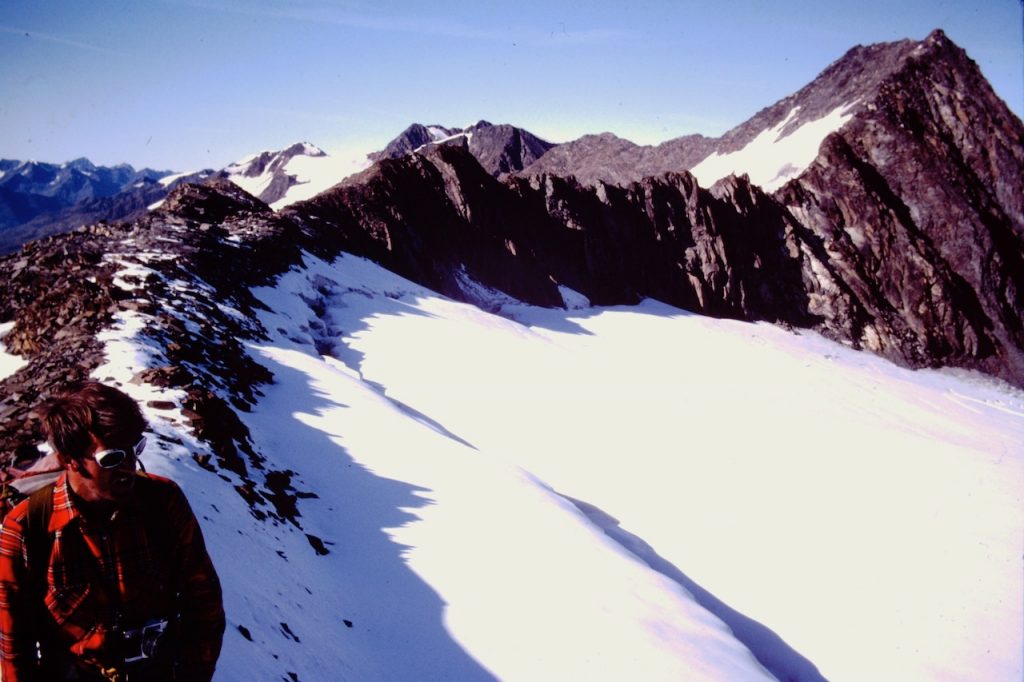
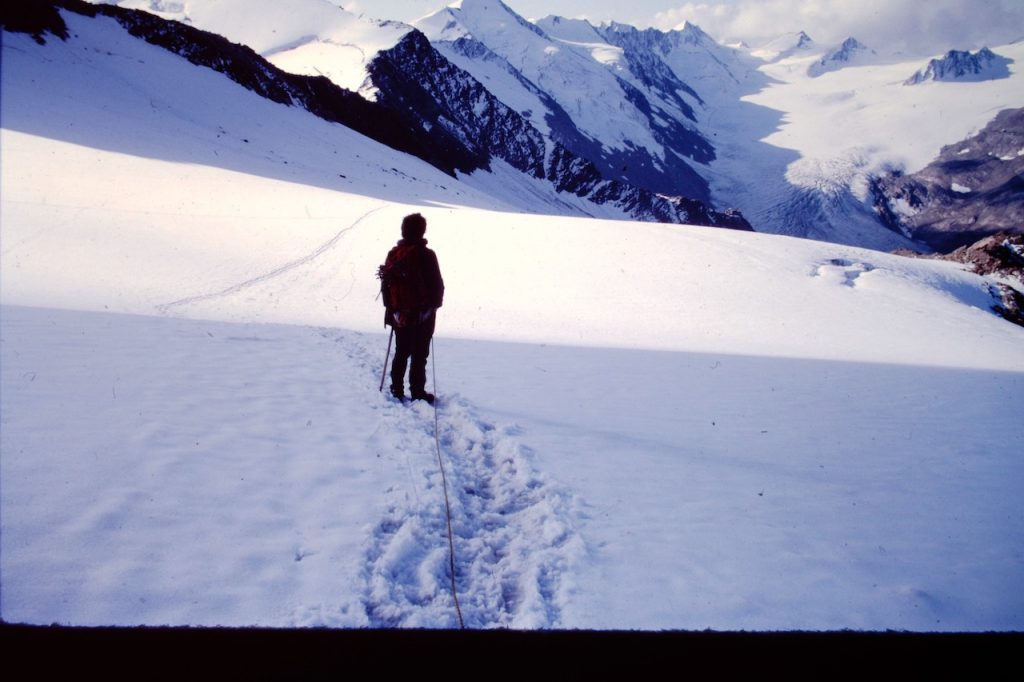
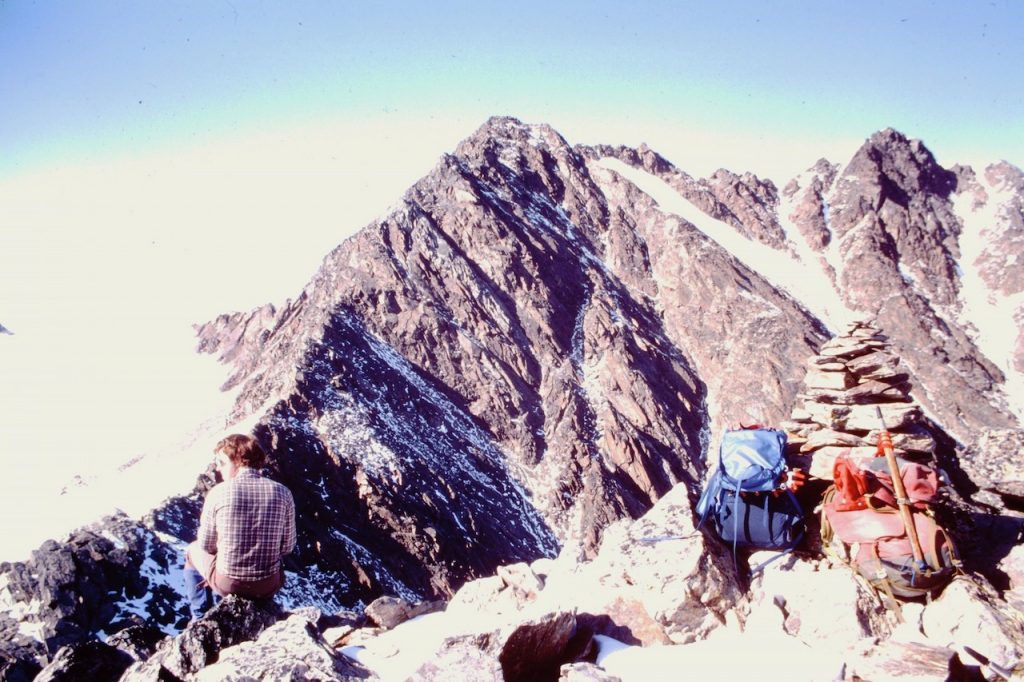
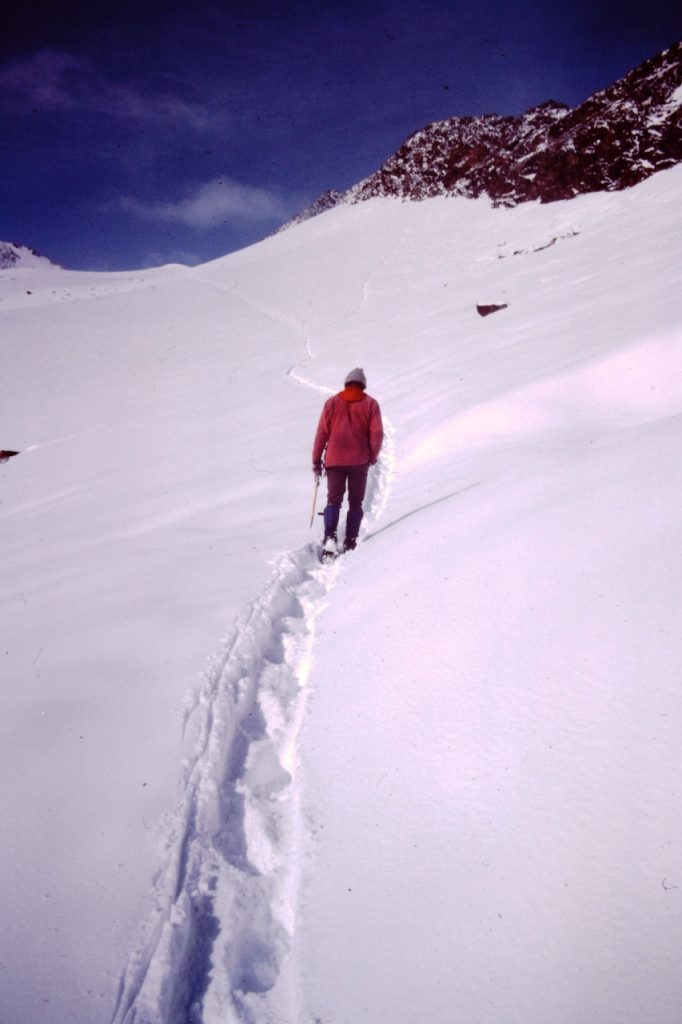
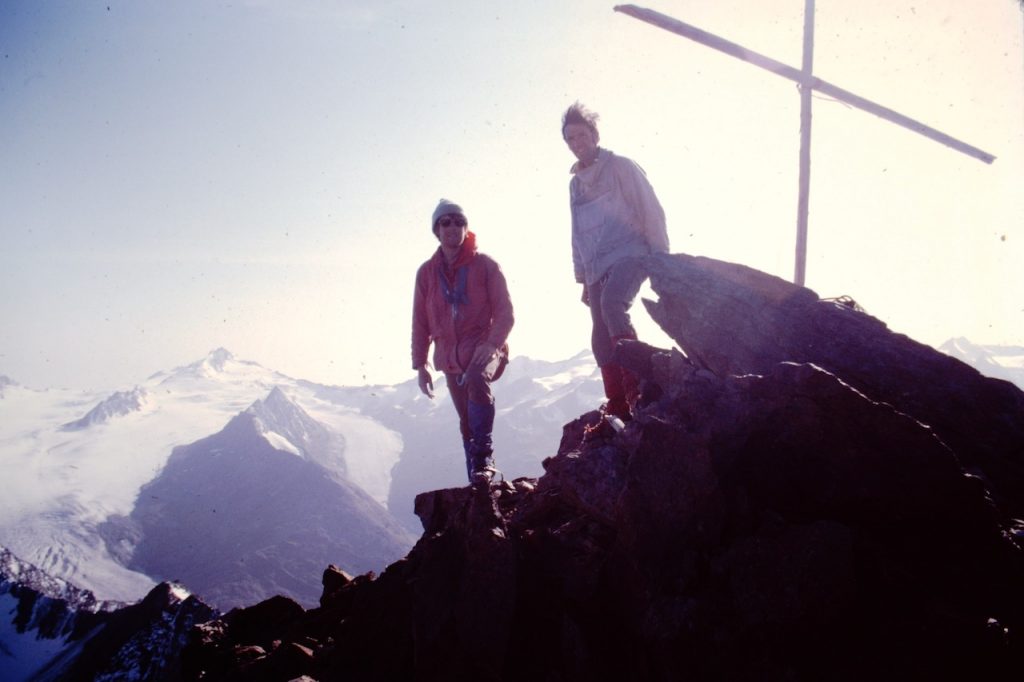
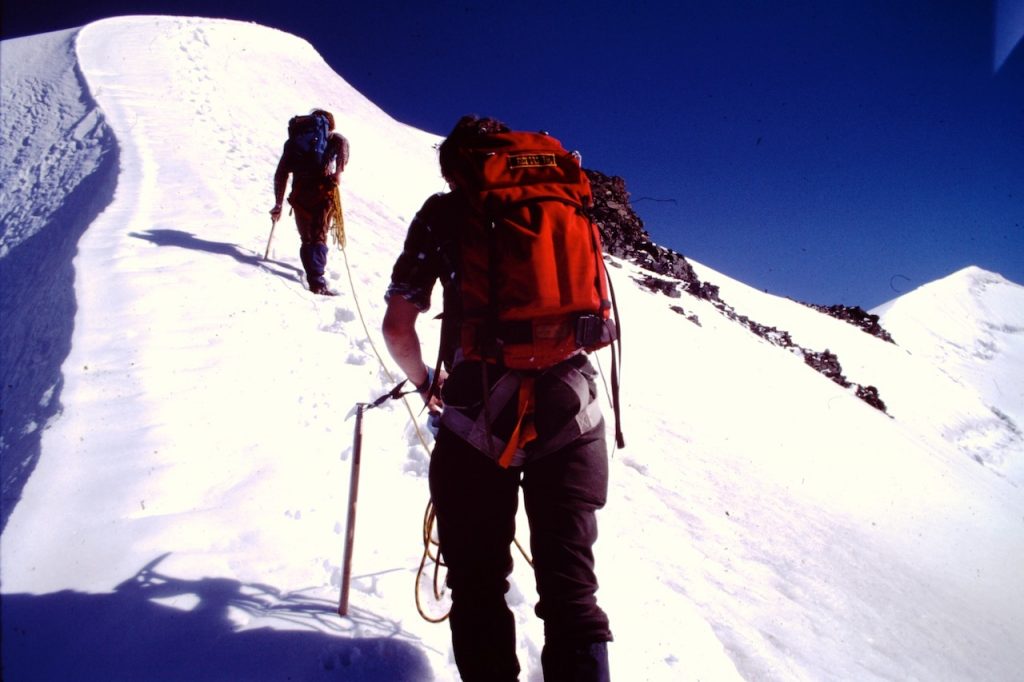
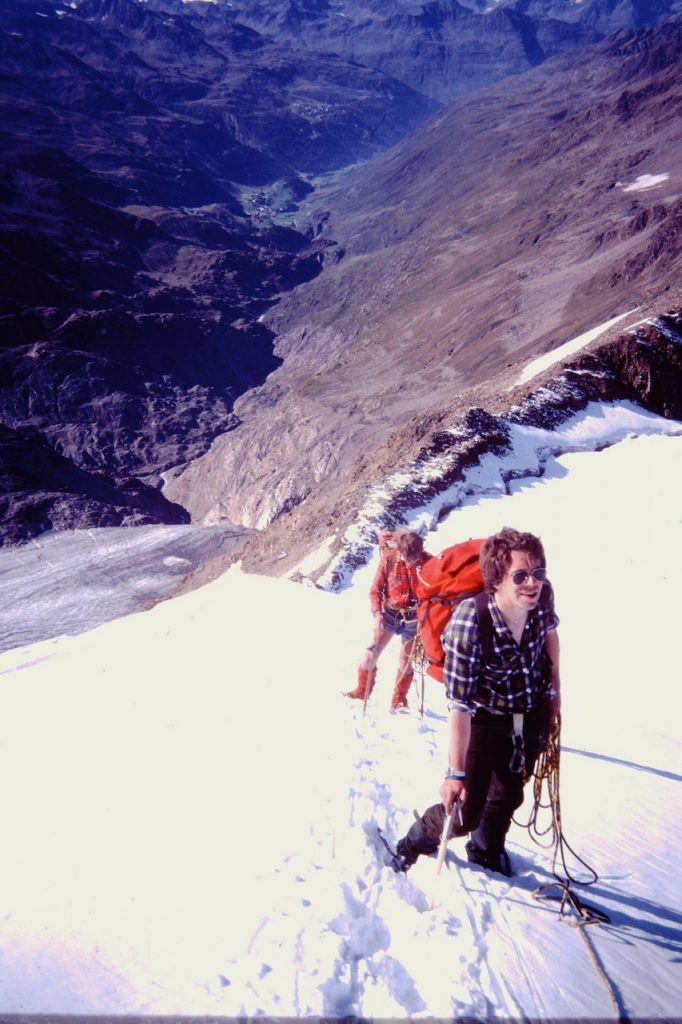
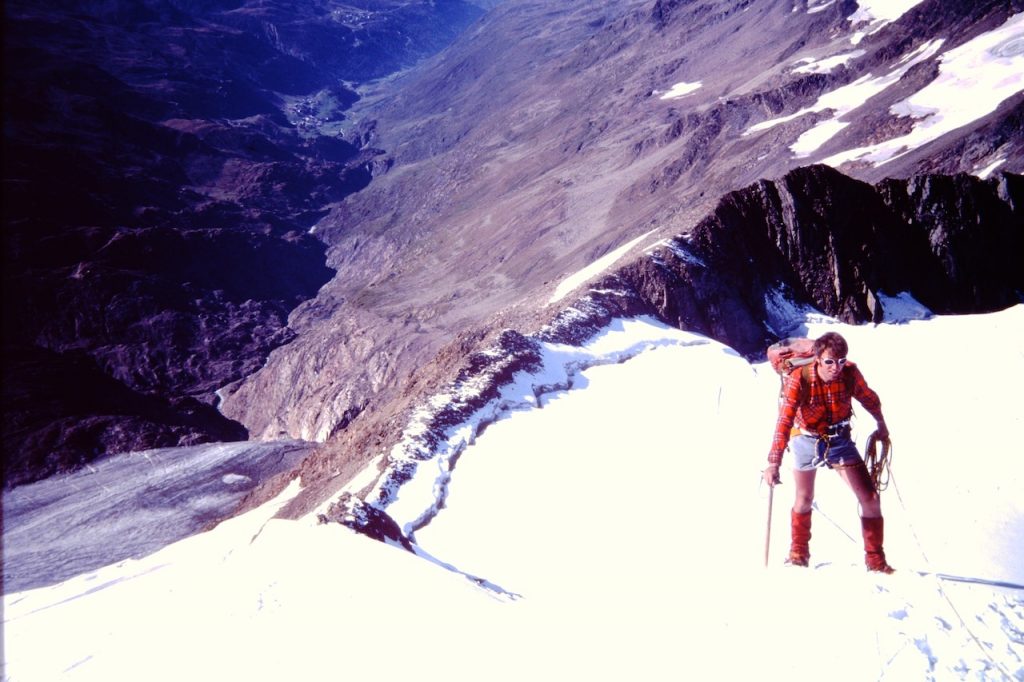
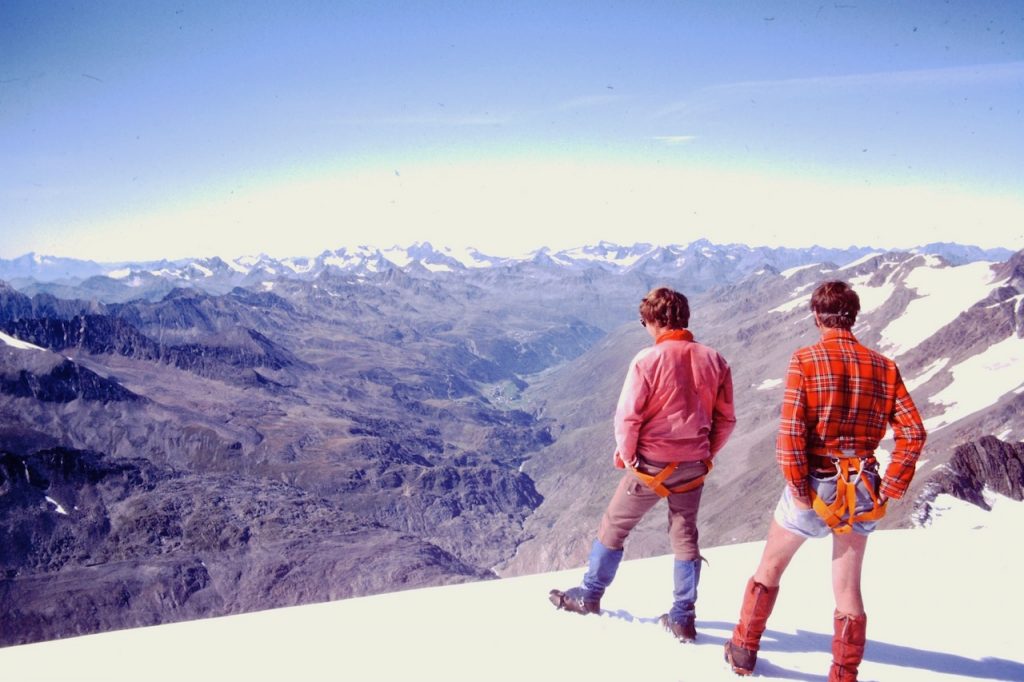
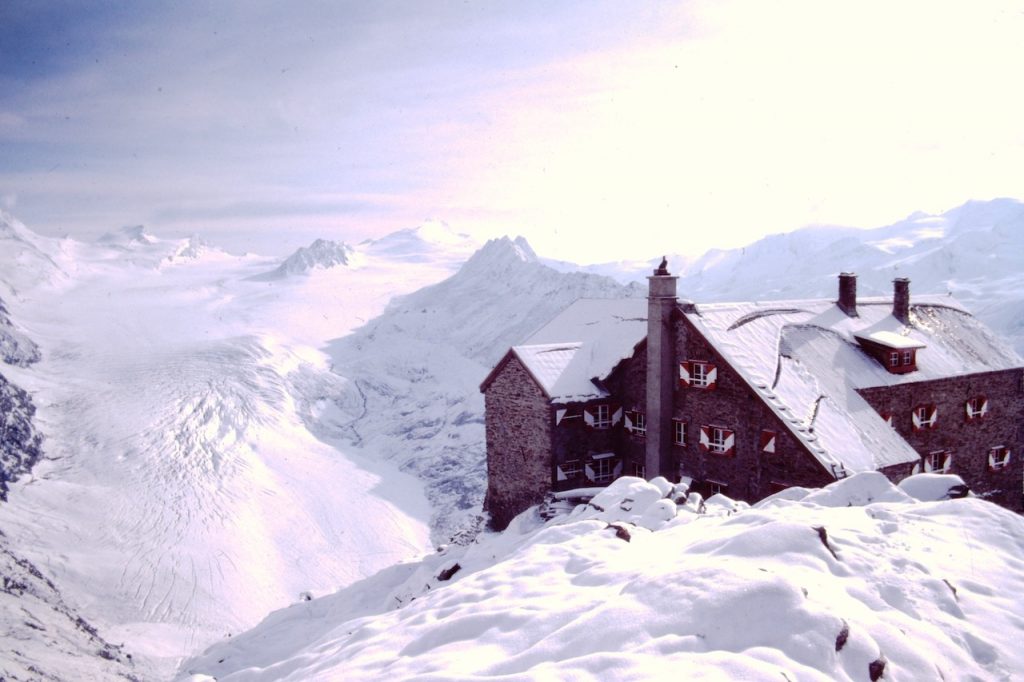
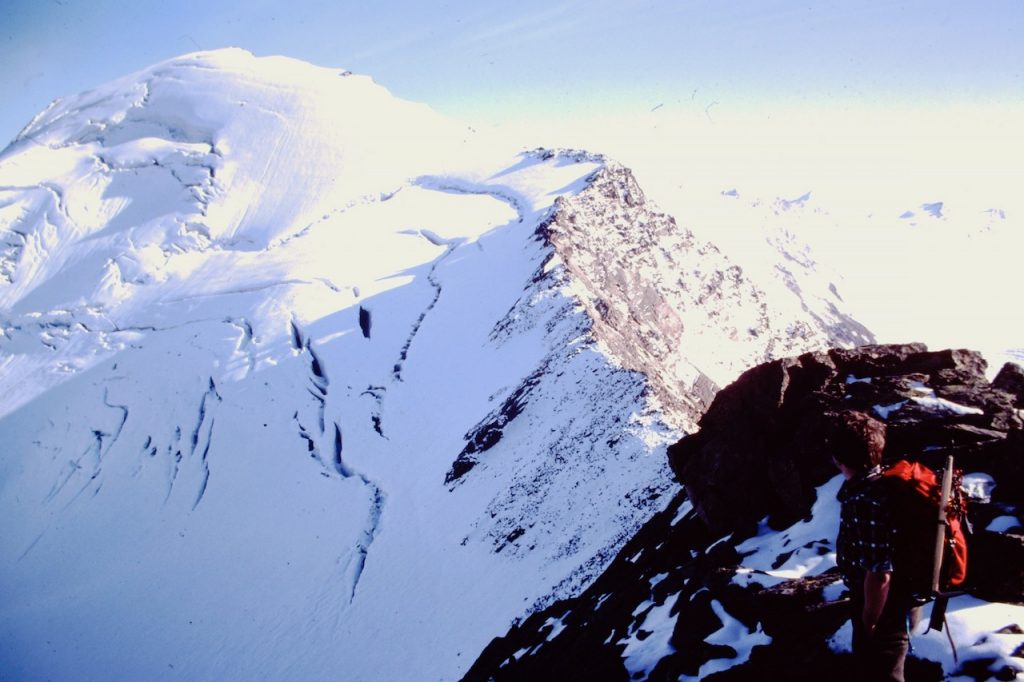
We set off for home on either the Friday or Saturday; I cannot remember which day it was. The first stage was to hike down the track to Obergurgl. We had noted the time of postbusses to Innsbruck on the Wednesday and so had a plan. The bus ride had its moments. It was empty when we boarded and filled up gradually as we moved towards the city. Of course we had had a very sweaty week and had not had a proper wash, shower or bath for at least seven days. We smelled that way too. On one occasion a person saw an empty seat near us, sat down and soon moved away! By the time we had reached Innsbruck the bus was full and passengers had to tolerate the stink.
Innsbruck has been the site of the Winter Olympics on a number of occasions and we found very satisfactory accommodation in the Olympic Village, which is a hostel under normal circumstances. I cannot remember anything about what or where we ate, but I do call two things. The first was a walk around town and some revisiting of places that I had seen on the School Trip from 1965. The other was having a shower and enjoying it very much.
In preparation for the flight home, we managed to pack all the ice axes in Phil’s tall rucksack, then we were off to the train. Innsbruck railway station impressed me for its cleanliness and modernity. Pretty much as I recalled from 1965. The train ride to Munich was slower than I expected. At one point the ticket inspector told me to take my boots off the seat (I was tired and needed a rest), but we arrived at the airport in plenty of time.
True to Dan Air’s reputation, our flight was seriously delayed. There was lot of waiting until an announcement that it was so late that the plane would not be able to get to Munich before the airport closed for the night at 10:00 pm. The nearest airport that would be open was Nuremberg – I want to say that it was a 4 hour bus ride. So off we went on the transport provided by the airline. We arrived at Gatwick very early in the morning. Phil might even have had to drive up to Manchester and get to work that day. Somehow I seem to remember Dave and I being bleary eyed in the office. To be fair to Dan Air, I think that the weather was a big factor in the delay; the flight had been very bumpy.
The story does not end here. In order to reclaim the money for the lost ice axes Dave had given full contact information. A few weeks after our return home Dave received a phone call telling him that the axes had been found in the cargo hold of an airplane, presumably the BAC One-Eleven that had taken us out. The airline then said that they would return these axes and we must give them the new ones that we had bought! What an airline would do with ice axes I cannot imagine, but anyway the transaction went ahead and I still have that prodigal axe. I must say that it’s a very good one; not too heavy either, but these days I have an all metal one that’s a bit longer.
So ended the first big trip that I had undertaken with two people that became very good and valued friends and with whom I have done many hikes over the years since 1982.
